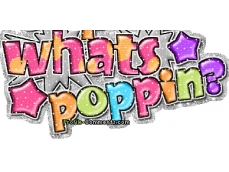Deprecated: Function ereg_replace() is deprecated in /mnt/web-data1/streetdance_cz/public_html/www/moduls/news/show_one.php on line 8
Deprecated: Function ereg_replace() is deprecated in /mnt/web-data1/streetdance_cz/public_html/www/moduls/news/show_one.php on line 9
WHAT IS A POPPING

NEWS
Author: F2312.12.2009, Nr. of subscription: 0, Viewed: 4894x
*What is Popping?*
Popping is a style of Hip Hop dance and one of the original funk styles of dance that came out of Fresno, CA in the 1970s. It is based on the technique of quickly contracting and relaxing muscles to cause a jerk in the dancer's body, referred to as a POP or a HIT. This is done continuously to the rhythm of a song in combination with various movements and poses. Popping is also used as an umbrella term to refer to a group of closely related illusionary dance styles and techniques that are often integrated with Popping to create a more varied performance. A popping dancer is commonly referred to as a “Popper”.
*History*
In the 1970s, the pioneer Popping group “The Electric Boogaloos” (earlier known as the Electronic Boogaloo Lockers) greatly contributed to the spread of Popping, partly because of their appearance on the television program Soul Train. Their founder Sam Solomon (a.k.a. Boogaloo Sam) created a set of movements that evolved into the styles known today as Popping and Boogaloo after being inspired by one of the pioneer Locking groups known as The Lockers as well as a fad dance popular in the 1960s known as The Jerk. While dancing, Sam would say the word "Pop" every time he flexed his muscles, eventually leading to the dance being called Popping.
"While Sam was creating Popping and Boogaloo, others were creating and practicing unique styles of their own. Back in the day many different areas in the west coast were known for their own distinct styles, each with their own rich history behind them. Some of these areas included Oakland, Sacramento and San Francisco".
The Electric Boogaloos
*Styles & Techniques*
Popping is centered on the technique of popping (or hitting), which means to quickly contract and relax muscles to create a jerking effect (a pop or hit) in the body. Popping can be concentrated to specific body parts creating variants such as arm pops, leg pops, chest pops and neck pops. They also can vary in explosiveness. Stronger pops normally involve popping both the lower and upper body simultaneously.
Normally pops, or hits, are performed at regular intervals timed to the beat of the music, causing the dance to appear very rhythmic in nature. A common technique of transitioning between poses is the dime stop, heavily utilized in robot dancing, which basically means to end a movement with an abrupt halt (thus "stopping on a dime"), after which a pop normally occurs.
Poses in popping make heavy use of angles, mime style movements and facial expressions. The lower body has many ways to move around from basic walking and stepping to the more complex and gravity defying styles of floating and electric boogaloo. Movements and techniques used in popping are generally focused on sharp contrasts, being either robotic and rigid or very loose and flowing.
As opposed to breaking and its floor-oriented moves, popping is almost always performed standing up, except in rare cases when the dancer goes down on the knees or even lies down for a short while to perform a special move.
There are a number of dance styles and techniques that are commonly mixed with popping to enhance the dancer's performance and create a more varied show, many of which are seldom seen outside of popping contexts. That is why these moves can be considered a part of popping when using it as an umbrella term.
Animation
A style and a technique where you imitate film characters being animated by stop motion. The technique consists of moving rigidly and jerky by tensing muscles and using techniques similar to strobing and the robot to make it appear as if the dancer has been animated frame by frame. This style was heavily inspired by the dynamation films created by Ray Harryhausen, such as The Seventh Voyage of Sinbad (1958).
Electric Boogaloo
A loose and fluid style trying to give the impression of a body lacking bones; partly inspired by animated movies and cartoons. It utilizes circular rolls of various body parts, such as the hips, knees and head, as well as isolation and sectioning, like separating the rib cage from the hip. It was developed in 1976 by Boogaloo Sam. The Electric Boogaloo is the signature style of the Electric Boogaloos.
Bopping
A style of popping in which the chest is isolated by being pushed out and brought back while flexing the chest muscles. As this movement is performed to the beat the popper can incorporate different moves in between the chest bop. When practiced the chest bop can be done at a double-time interval adding a unique effect to the move.
Cobra
Similar to a Boogaloo, except you roll your chest like a snake.
Crazy Legs
A leg-oriented style focusing on fast moving legs, knee rolls and twisting feet. Developed in 1980-81 by Popin' Pete, originally inspired by the fast and agitated style of break-dance by the famous B-boy Crazy Legs from Rock Steady Crew.
Dime Stopping
A technique of moving at a steady pace and then abruptly coming to a halt, as if attempting to stop on a dime. This is often combined with a pop at the beginning and/or end of the movement.
Fast Forward
The concept of moving faster than normal, like being part of a video being played in fast forward.
Floating, gliding and sliding
A set of footwork-oriented techniques that attempt to create the illusion that the dancer's body is floating smoothly across the floor, or that the legs are walking while the dancer travels in unexpected directions. Encompasses moves such as the moonwalk (sliding).
Fresno
A move, which defines all that is essential in Popping (also used in electric boogaloo). The Fresno can be performed in various different ways as only the following requirements exist. In a Fresno, the dancer moves side-to-side doing a hit on each turn with the leg and arm of the side the dancer has moved to.
Liquid dancing
An illusionary dance style that focuses on flowing and continuous liquid-like motions, with concentration on the fingers, hands and arms. It is stylistically connected to – and often mixed with – waving. Liquid dancing is common in rave culture, and some dancers consider it a complete style of its own.
Miming
Performing techniques of traditional miming to the beat of a song. Most commonly practiced are various movements with the hands as if one could hold onto air and pull their body in any possibly direction. Miming can also be used to allow a popper to tell a story through his or her dance. This style is often used in battles to show the opponent how they can defeat them.
Old Man
Inspired by watching an old man who had one of his leg deformed and had walking difficulty, Off that, Boogaloo Sam saw inspiration and worked with that move.
Puppet
A style imitating a puppet or marionette tied to strings. Normally performed alone or with a partner acting as the puppet master pulling the strings.
Robot
A style imitating a robot or mannequin.
Scarecrow
A style imitating the scarecrow character of The Wizard of Oz. Created by Boogaloo Sam in 1977. Focuses on out-stretched arms and rigid poses contrasted with loose hands and legs.
Slow motion
Moving very slowly with exaggerated movements to make it appear as if the dancer is viewed in slow motion.
Strobing
A style of popping that gives the impression that the dancer is moving within a strobe light. To produce this effect, a dancer will take any ordinary movement (such as waving hello to someone) in conjunction with quick, short stop-and-go movements to make a strobing motion. Mastering strobing requires perfect timing and distance between each movement.
Ticking
A way of popping where the dancer pops at smaller intervals, generally twice as fast as normal.
Toyman
Based on action figures such as G.I. Joe and Major Matt Mason, developed by an old member of the Electric Boogaloos called Toyman Skeet. Goes between straight arms and right angles to simulate limited joint movement.
Tutting/King Tut
Inspired by the art of Ancient Egypt, tutting exploits the body's ability to create geometric positions and movements, predominantly with the use of right angles.
Twist or Flex
Moving only one body part at a time, which gives the impression that the body is twisting.
Vibrating
Tensing muscles very hard, causing them to shake or vibrate.
Walk-out
A move commonly used to change positions.
Waving
Waving is composed of a series of fluid movements that give the appearance that a wave is traveling through the dancer's body. It is often mixed with liquid dancing.
Popping Artists
“The King of Pop” Michael Jackson's Billie Jean performance, which included the famous moonwalk, at Motown's 25th Anniversary in 1983 was influenced by the legendary dancer and popper Jeffrey Daniel. Jeffrey Daniel originally called the moonwalk the "Backslide". The Backslide was already known to poppers and mime artists, but it was made famous by Michael Jackson's performance. Michael Jackson was coached by Bruno "Poppin Taco" Falcon and Timothy "Poppin Pete" Solomon. Although this introduced a new naming confusion as the moonwalk was already known by a different name in popping contexts (the backslide, floating) before Jackson made the move famous, he was very influential in popularizing Popping and the Robot, as he developed a style of his own and became a legendary artist in Popping.
Others:
-Salah Benlemqawanssa
-Robert Muraine"mr.fantastic
-Michael "Boogaloo Shrimp" Chambers
-Steffan "Mr. Wiggles" Clemente
-Steven "Skeeter Rabbit" Nichols
-Bruno "Poppin Taco" Falcon
-Suga Pop
-Nam "Poppin'" Hyun Joon
-"Boogaloo" Sam Solomon
-Timothy "Popin' Pete" Solomon
“Poppin Q-trix” article
F23

















































































